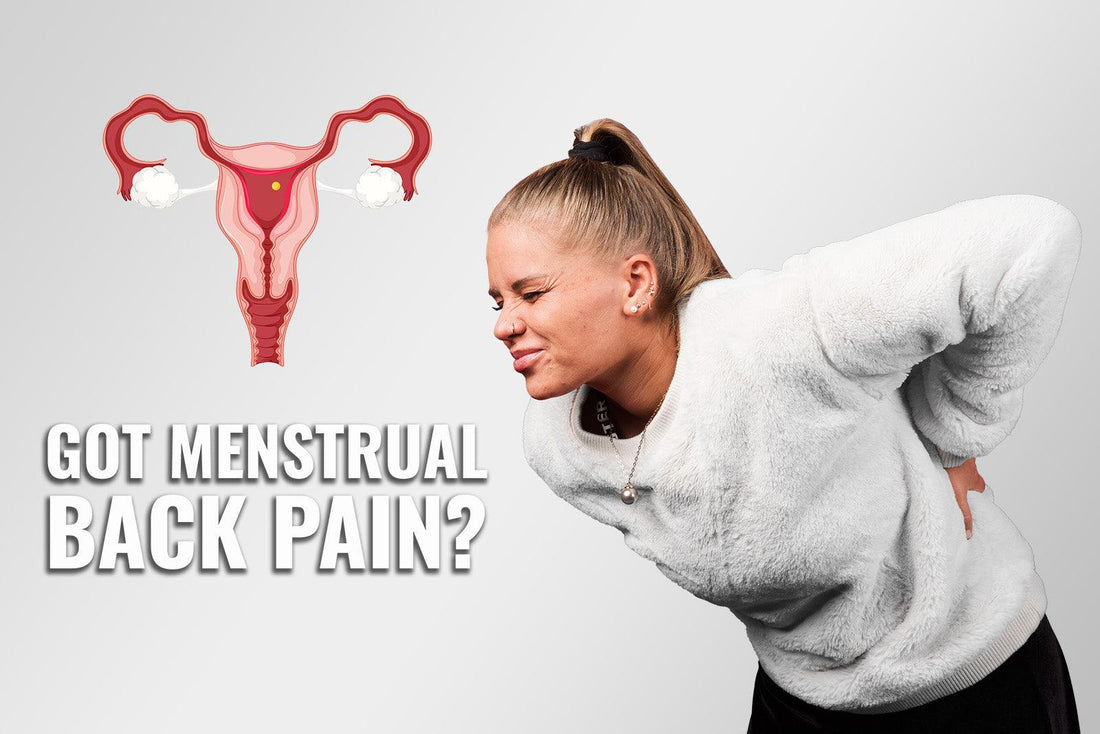Is it normal to get menstrual back pain?
Yes! Menstrual back pain is a common yet overwhelming symptom of periods. It might be a slight discomfort for some women, while for others it may be havoc.
"But why do I get back cramps on my period?"
You may suffer from back pain due to PMS, PMDD, dysmenorrhea, endometriosis, Adenomyosis, or PID.
Keep reading to discover what these conditions are and how they can contribute to menstrual back pain.
Here's what you'll learn.
- Why Does Menstrual Cycle Cause Pain?
- Why Do I Get Menstrual Back Pain?
- Can Menstrual Cramps Cause Back Pain?
- 6 Causes Of Back Pain And Cramps During Period
- PMS
- PMDD
- Dysmenorrhea
- Endometriosis
- Adenomyosis
- Other Menstrual Conditions Causing Lower Back Pain
- 5 Home Remedies For Menstrual Back Pain Relief
- Pain Relief Medication
- Heat Therapy And Warm Baths
- Massage
- Exercise
- Maintaining A Healthy Diet
- Vitamin B1
- Magnesium
Why Does Menstrual Cycle Cause Pain?
Why do I get back cramps on my period every single month?
Is that a question you ask yourself each month while growling in pain?
Periods or more sophisticatedly called Menstrual Cycles, is a natural phenomenon of preparing your body to welcome a fertilized egg. If the egg is fertilized, pregnancy continues. But if it doesn't, the lining inside your uterus, also called the endometrium, starts shedding.
This means that every month, your uterus will shed its lining – the endometrial lining, which causes the ultimate bloodshed. During this shedding, the muscles and blood vessels in your uterus contract, causing lower abdominal muscle pain and back pain, also known as menstrual cramps and back pain.
Why Do I Get Menstrual Back Pain?
After this natural phenomenon, there are a few other contributing factors that add up to your pain.
The number one reason is that when the uterus is shedding its lining. The blood prepares to flow out of your body, your body's natural mechanism causes a constriction of the uterus muscles and blood vessels. This constriction is responsible for menstrual cramps.
On the other hand, the uterus also prepares to break down the endometrial cells. A large amount of inflammatory prostaglandins starts to release at the site of tissue damage. Hence, these prostaglandins (hormone-like chemical messengers) are also responsible for constricting the blood vessels and the muscles, causing pain.
Can Menstrual Cramps Cause Back Pain?
The pain related to the menstrual cycle is mostly associated with the lower abdomen. However, in some individuals, this pain can shift towards the back, causing menstrual back pain. Menstrual lower back pain is most common in women suffering from PMS, PMDD, dysmenorrhea, or even endometriosis.
Let's discuss all these problems in detail so that you can identify the cause of your menstrual lower back pain. Make sure to contact your healthcare provider if the pain is getting unbearable for you!
6 Causes Of Back Pain And Cramps During Period
PMS
PMS, also known as Premenstrual Syndrome, is a group of symptoms associated with the menstrual cycle. These symptoms can range from mood swings, food cravings, bloating, diarrhea, severe abdominal cramping, and back pain.
A study concluded that women with high CRP levels (inflammatory markers) during PMS were more likely to have lower back pain during menstrual cycle. [1]
PMDD
PMDD, also called Premenstrual Dysphoric Disorder, is a much more severe version of PMS. The exact cause of PMDD is still unknown. However, hormonal changes may cause serotonin deficiency that increases blood vessel constriction. This means extra pressure on your blood vessels, hence higher pain levels.
Dysmenorrhea
Dysmenorrhea is regarded as severe and frequent menstrual cramps that can radiate towards the lower abdomen and back.
Dysmenorrhea is a common menstrual disorder. Research conducted on 300 women age 18-25 determined the prevalence of dysmenorrhea. Researchers found that more than 84% of women suffered from primary dysmenorrhea, of which 16% complained about lower back pain from the menstrual cycle. [2]
Endometriosis
Endometriosis is a severe menstrual disorder that needs urgent attention. Endometriosis is a condition in which the endometrial lining that grows inside your uterus begins to grow outside the uterus and towards the ovaries and fallopian tubes.
It is an extremely painful condition with heavy bleeding and severe pain. The pain associated with endometriosis travels all the way from your lower abdomen to your back.
Adenomyosis
Adenomyosis is similar to endometriosis, the difference is that the endometrial tissue gegins growing within the muscular walls of the uterus instead of outside the walls. Its pain may radiate from the back to even down the legs.
Research has shown that chiropractic care and topical heat relieved lower back pain associated with Adenomyosis. [3]
Other Menstrual Conditions Causing Lower Back Menstrual Pain:
Other menstrual conditions that may cause lower back with menstrual abnormalities are PID (Pelvic Inflammatory Disease and Uterine Fibroids.
5 Home Remedies For Menstrual Back Pain Relief
Finding the best menstrual back pain remedies are a great way to combat the growing menstrual back pain problem.
Here are 5 SUPMOGO-Approved at-home menstrual back pain relief remedies!
Pain Relieve Medication:
The most approached pain relief method is using over-the-counter pain relievers. NSAIDs like acetaminophen or anti-inflammatory medications such as ibuprofen or naproxen inhibit prostaglandins production, causing a pain-relieving effect.
A study found that regular use of NSAIDs may lead to stomach problems, fluid retention, hypertension, and kidney and heart problems. Therefore, regular use of painkillers are not recommended as a long-term approach.
Heat Therapy And Warm Baths:

Don't you love hopping into a warm bath while a constant war is going on down there?
Heat therapy and warm baths have proven to be equally effective as painkillers. They can provide instant relief from period back pain. If you want to stay away from medication, hopping into a warm bath or wearing the SUPMOGO Recovery Flex System Belt can be great alternatives to medication.
The SUPMOGO belt features Advanced Targeting Technology that is water-activated. It generates heat underneath the belt and relieves the unbearable period pains. Pain-relieving medication can take a few hours to calm the thunder, the SUPMOGO Belt can swirl its magic in just a couple minutes!
Its thin and flexible material makes it easy to wear underneath your clothes while you're at work or at home.
Massage
A good, calming massage can help your body relax, become stress-free, and lower the stress load on your reproductive system. A lower abdomen and back massage can reduce uterine spasms and relax the uterus.
There's no harm in getting a full body massage since it can help calm and relieve muscle strain. Stress also lowers your threshold for pain; hence relaxation techniques like hot oil massages, meditation, and yoga are highly beneficial. [4]
Exercise

Regularly exercising is a great way to keep menstrual cycle back pain at bay!
It enhances the release of beta-endorphins that help block the pain receptors. It also pushes prostaglandins out of your system to lower pain levels.
30 minutes of aerobic exercise for minimum 3 times per week can save you from crawling into bed every month!
Maintaining a Healthy Diet:
This one always stays crucial in all sorts of diseases. Vitamins and Minerals that are specifically necessary for reducing period pain are Vitamin B1 and Magnesium.
Vitamin B1:
Vitamin B1 or Thiamin has proven to reduce physical and mental symptoms of PMS. You can also use a combination of vitamin B1 and B3 to reduce the severity of your symptoms. It also reduces other menstrual symptoms like nausea, vomiting, and fatigue. [5]
Magnesium:
Magnesium is well-known for its muscle relaxant properties. Therefore, it is efficacious in relaxing the smooth muscle contraction of your uterus. It also lowers the release of prostaglandins.
Research has shown that Magenium, combined with Vitamin B6, is effective in relieving bad back pain. [6]
Summing Up!
Menstrual back cramps are common, but if the severity of your pain is beyond your pain threshold, it's time to get assessed for the above-mentioned menstrual problems.
Severe back pain in the menstrual cycle is usually a sign of any underlying health condition that might exacerbate your pain. The menstrual back pain remedies mentioned above are a great way to help you get through the pain. But if these remedies do not work for you, your condition might get worse. Do not hesitate to reach out to your healthcare provider for immediate attention.
Suggested Article For You - 5 Best Practices For Menstrual Pain Relief.
The SUPMOGO Belt is a quick fix for your menstrual back pain without worrying about heating the towels again and again. Its Advanced Targeting Technology gets to the root of what's causing your pain while naturally generating heat to relieve pain and reduce bloating.
Try the SUPMOGO Recovery Flex System Belt today with a 60-days risk-free money-back guarantee!

[1] Gold, E. B., Wells, C., & Rasor, M. O. N. (2016). The association of inflammation with premenstrual symptoms. Journal of women's health, 25(9), 865-874.
[2] Kural, M., Noor, N. N., Pandit, D., Joshi, T., & Patil, A. (2015). Menstrual characteristics and prevalence of dysmenorrhea in college going girls. Journal of family medicine and primary care, 4(3), 426.
[3] Jensen, A. M., Bewketu, B., & Sanford, D. (2011). Intermittent low back pain referred from a uterine adenomyosis: a case report. Journal of Chiropractic Medicine, 10(1), 64-69.
[4] Dufton, L. M., Konik, B., Colletti, R., Stanger, C., Boyer, M., Morrow, S., & Compas, B. E. (2008). Effects of stress on pain threshold and tolerance in children with recurrent abdominal pain. Pain, 136(1-2), 38-43.
[5] Abdollahifard, S., Koshkaki, A. R., & Moazamiyanfar, R. (2014). The effects of vitamin B1 on ameliorating the premenstrual syndrome symptoms. Global journal of health science, 6(6), 144.
[6] Fathizadeh, N., Ebrahimi, E., Valiani, M., Tavakoli, N., & Yar, M. H. (2010). Evaluating the effect of magnesium and magnesium plus vitamin B6 supplement on the severity of premenstrual syndrome. Iranian journal of nursing and midwifery research, 15(Suppl1), 401.

